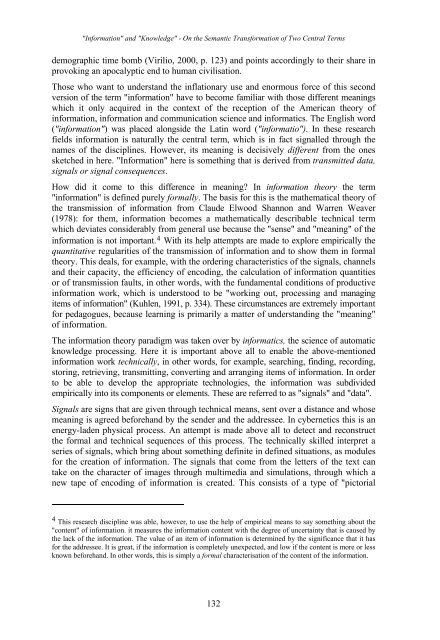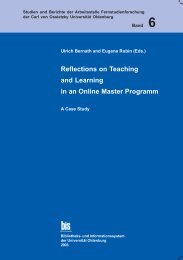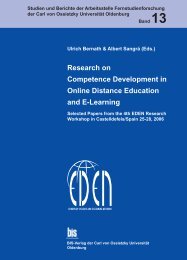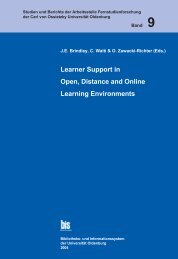Distance Education in Transition - Master of Distance Education ...
Distance Education in Transition - Master of Distance Education ...
Distance Education in Transition - Master of Distance Education ...
You also want an ePaper? Increase the reach of your titles
YUMPU automatically turns print PDFs into web optimized ePapers that Google loves.
"Information" and "Knowledge" - On the Semantic Transformation <strong>of</strong> Two Central Terms<br />
demographic time bomb (Virilio, 2000, p. 123) and po<strong>in</strong>ts accord<strong>in</strong>gly to their share <strong>in</strong><br />
provok<strong>in</strong>g an apocalyptic end to human civilisation.<br />
Those who want to understand the <strong>in</strong>flationary use and enormous force <strong>of</strong> this second<br />
version <strong>of</strong> the term "<strong>in</strong>formation" have to become familiar with those different mean<strong>in</strong>gs<br />
which it only acquired <strong>in</strong> the context <strong>of</strong> the reception <strong>of</strong> the American theory <strong>of</strong><br />
<strong>in</strong>formation, <strong>in</strong>formation and communication science and <strong>in</strong>formatics. The English word<br />
("<strong>in</strong>formation") was placed alongside the Lat<strong>in</strong> word ("<strong>in</strong>formatio"). In these research<br />
fields <strong>in</strong>formation is naturally the central term, which is <strong>in</strong> fact signalled through the<br />
names <strong>of</strong> the discipl<strong>in</strong>es. However, its mean<strong>in</strong>g is decisively different from the ones<br />
sketched <strong>in</strong> here. "Information" here is someth<strong>in</strong>g that is derived from transmitted data,<br />
signals or signal consequences.<br />
How did it come to this difference <strong>in</strong> mean<strong>in</strong>g? In <strong>in</strong>formation theory the term<br />
"<strong>in</strong>formation" is def<strong>in</strong>ed purely formally. The basis for this is the mathematical theory <strong>of</strong><br />
the transmission <strong>of</strong> <strong>in</strong>formation from Claude Elwood Shannon and Warren Weaver<br />
(1978): for them, <strong>in</strong>formation becomes a mathematically describable technical term<br />
which deviates considerably from general use because the "sense" and "mean<strong>in</strong>g" <strong>of</strong> the<br />
<strong>in</strong>formation is not important. 4 With its help attempts are made to explore empirically the<br />
quantitative regularities <strong>of</strong> the transmission <strong>of</strong> <strong>in</strong>formation and to show them <strong>in</strong> formal<br />
theory. This deals, for example, with the order<strong>in</strong>g characteristics <strong>of</strong> the signals, channels<br />
and their capacity, the efficiency <strong>of</strong> encod<strong>in</strong>g, the calculation <strong>of</strong> <strong>in</strong>formation quantities<br />
or <strong>of</strong> transmission faults, <strong>in</strong> other words, with the fundamental conditions <strong>of</strong> productive<br />
<strong>in</strong>formation work, which is understood to be "work<strong>in</strong>g out, process<strong>in</strong>g and manag<strong>in</strong>g<br />
items <strong>of</strong> <strong>in</strong>formation" (Kuhlen, 1991, p. 334). These circumstances are extremely important<br />
for pedagogues, because learn<strong>in</strong>g is primarily a matter <strong>of</strong> understand<strong>in</strong>g the "mean<strong>in</strong>g"<br />
<strong>of</strong> <strong>in</strong>formation.<br />
The <strong>in</strong>formation theory paradigm was taken over by <strong>in</strong>formatics, the science <strong>of</strong> automatic<br />
knowledge process<strong>in</strong>g. Here it is important above all to enable the above-mentioned<br />
<strong>in</strong>formation work technically, <strong>in</strong> other words, for example, search<strong>in</strong>g, f<strong>in</strong>d<strong>in</strong>g, record<strong>in</strong>g,<br />
stor<strong>in</strong>g, retriev<strong>in</strong>g, transmitt<strong>in</strong>g, convert<strong>in</strong>g and arrang<strong>in</strong>g items <strong>of</strong> <strong>in</strong>formation. In order<br />
to be able to develop the appropriate technologies, the <strong>in</strong>formation was subdivided<br />
empirically <strong>in</strong>to its components or elements. These are referred to as "signals" and "data".<br />
Signals are signs that are given through technical means, sent over a distance and whose<br />
mean<strong>in</strong>g is agreed beforehand by the sender and the addressee. In cybernetics this is an<br />
energy-laden physical process. An attempt is made above all to detect and reconstruct<br />
the formal and technical sequences <strong>of</strong> this process. The technically skilled <strong>in</strong>terpret a<br />
series <strong>of</strong> signals, which br<strong>in</strong>g about someth<strong>in</strong>g def<strong>in</strong>ite <strong>in</strong> def<strong>in</strong>ed situations, as modules<br />
for the creation <strong>of</strong> <strong>in</strong>formation. The signals that come from the letters <strong>of</strong> the text can<br />
take on the character <strong>of</strong> images through multimedia and simulations, through which a<br />
new tape <strong>of</strong> encod<strong>in</strong>g <strong>of</strong> <strong>in</strong>formation is created. This consists <strong>of</strong> a type <strong>of</strong> "pictorial<br />
4 This research discipl<strong>in</strong>e was able, however, to use the help <strong>of</strong> empirical means to say someth<strong>in</strong>g about the<br />
"content" <strong>of</strong> <strong>in</strong>formation. it measures the <strong>in</strong>formation content with the degree <strong>of</strong> uncerta<strong>in</strong>ty that is caused by<br />
the lack <strong>of</strong> the <strong>in</strong>formation. The value <strong>of</strong> an item <strong>of</strong> <strong>in</strong>formation is determ<strong>in</strong>ed by the significance that it has<br />
for the addressee. It is great, if the <strong>in</strong>formation is completely unexpected, and low if the content is more or less<br />
known beforehand. In other words, this is simply a formal characterisation <strong>of</strong> the content <strong>of</strong> the <strong>in</strong>formation.<br />
132





